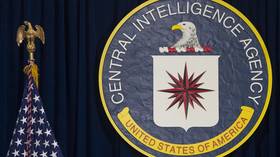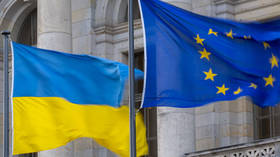The story of how the CIA conducted secret LSD experiments on unwitting US citizens

After World War II, the possibility of gaining control over a person’s mind became one of the top pursuits for intelligence services. Amid never-ending spy games, the capacity to make someone tell the full truth during an interrogation, or to wipe out a subject’s personality and impose another – perhaps, a controlled one – became quite attractive to secret services.
In 1979, former US State Department officer John Marks published a book called 'The Search for the ‘Manchurian Candidate’’, which focused on the CIA's mind-control experiments and is based on agency documents released under the Freedom of Information Act.
The term ‘Manchurian Candidate’ emerged from a title of a novel by Richard Condon, first published in 1959, which tells the story of a US soldier brainwashed and turned into an assassin by the Communists. Back then, the fear that America’s rivals might use such techniques was not only a fictional fantasy, but a matter of very serious concern.
This is how John Marks describes it: “In 1947 the National Security Act created not only the CIA but also the National Security Council – in sum, the command structure for the Cold War. Wartime [Office of Strategic Services] leaders like William Donovan and Allen Dulles lobbied feverishly for the Act. Officials within the new command structure soon put their fears and their grandiose notions to work. Reacting to the perceived threat, they adopted a ruthless and warlike posture toward anyone they considered an enemy – most especially the Soviet Union. They took it upon themselves to fight communism and things that might lead to communism everywhere in the world.”
‘Defensive orientation soon became secondary’
In 1975, this US Senate select committee, chaired by Democratic senator from Idaho Frank Church, looked into the possible intelligence abuses committed in the past. It was part of a so-called ‘Year of Intelligence,’ a series of investigations into the operations which included “illegal, improper or unethical activities,” as the resolution establishing the Church committee put it.
Actually, there were reasons for the US public to question the secret services’ methods. After the Watergate scandal, it was disclosed that the CIA had a direct role in what happened. While describing the CIA’s activities in his article for the New York Times, journalist Seymour Hersh mentioned other agencies’ operations targeting American citizens. The CIA itself only released the documents on the matter in 2007.
So, the Church committee had quite a lot of work to do. The members held 126 full committee meetings, 40 subcommittee hearings and interviewed some 800 witnesses. After having searched through 110,000 documents, the committee published its final report in April 1976. It also issued a document called 'Alleged Assasination Plots Involving Foreign Leaders', detailing the intelligence’s plans to kill several top figures like Patrice Lumumba and Fidel Castro.
The main report contains a huge chapter dedicated to the use of chemical and biological agents by the intelligence agencies. “Fears that countries hostile to the United States would use chemical and biological agents against Americans or America’s allies led to the development of a defensive program designed to discover techniques for American intelligence agencies to detect and counteract chemical and biological agents,” the report says, pointing that the defensive weapon soon turned into an offensive one.
The defensive orientation soon became secondary, as the possible use of these agents, to obtain information from or gain control over enemy agents, became apparent.
The report goes on to explain that the programs were so sensitive that “few people, even within the agencies” knew about their existence, and “there is no evidence that either the executive branch or Congress were ever informed.” As a result, scores of people suffered some damage and at least two of them died due to the experiments.
One grim example is the case of American tennis player Harold Blauer. In 1952, he voluntarily entered the New York State Psychiatric Institute because he was suffering from depression compounded by divorce. The institute had a classified contract with the Army for research of potential chemical warfare agents. As part of an experiment that he knew nothing about, Blauer was given a series of derivatives of a psychedelic substance called mescaline, and died. In 1987, a US court ruled that the government had covered up its role in the man’s death. A judge ordered the authorities to pay $700,000 to Blauer’s family.
Unwitting candidates
Since the late 1940s, the CIA ran several projects involving chemical and biological agents. From 1947 to 1953, a project called CHATTER researched “truth drugs” – something that, according to the Church commission’s report, was a response to “reports of ‘amazing results’ achieved by the Soviets.” Animals and humans underwent tests involving a plant called anabasis aphylla, an alkaloid scopolamine and mescaline.
In 1950, a project dubbed BLUEBIRD was approved. Its aim was to investigate mind-control methods that prevent personnel from “unauthorized extraction of information” and that give the user the means to control an individual using special interrogation techniques. A year later, the project was rebranded as ARTICHOKE. Apart from its defensive purposes, it now included research into “offensive interrogation techniques” involving hypnosis and drugs. There’s no certain information about when the project ended. According to the Church commission’s report, the CIA insisted that ARTICHOKE had been scrapped in 1956 – however, there was evidence that the “special interrogation” it studied had been used for several more years.
There was also MKNAOMI, which investigated biological warfare agents, their storage, and devices for their diffusion. It was scrapped after president Richard Nixon put an end to America's offensive biological weapons program in 1969.
MKULTRA
The CIA’s main mind-control research program, which turned out to be a real shock when discovered, was MKULTRA, headed by Dr Sidney Gottlieb. Launched in 1953 and discontinued a decade later, the program involved testing human behavior control with the likes of radiation, electroshock, psychological and psychiatric tools, harassment substances and paramilitary devices. The project had a special branch, MKDELTA, to oversee tests conducted abroad.
For the most part, people now know about MKULTRA because it involved LSD – a psychedelic drug created in 1938 by Swiss chemist Albert Hofmann at the Sandoz Laboratories in Basel, Switzerland. On April 19, 1943, Hofmann accidentally took LSD himself and discovered how strong the effect might be (this day is now known as ‘Bicycle day,’ as Hofmann was riding a bike when he experienced the first-ever ‘trip’ on LSD, commonly known as ‘acid’). Sandoz Laboratories began marketing the drug under the name ‘Delysid’ four years later, and in 1948 it came to the US.
The CIA knew about LSD’s effects, and relied on it so much that, in 1953, there was a plan to purchase 10 kilograms of LSD, some 100 million doses worth $240,000, for experiments.
The CIA, posing as a research foundation, made deals with universities, hospitals and other institutions to get the materials and substances it needed. The tests were performed on human subjects, with or without their knowledge. Even those who volunteered to take part in the research were unaware of the real purpose behind it. The CIA considered that the secrecy aspect was needed as, in a potential operation, the targeted subject would certainly be unwitting.
Several tests involving LSD were conducted in the army. It was also used abroad during interrogations of alleged foreign spies.
The hallucinogen was also tested on prisoners, sometimes on those with drug addictions. Several volunteer inmates from “Lexington Rehabilitation Center” – a prison for addicts serving sentences for drug violations – were given hallucinogenic drugs in exchange for drugs they were addicted to.
American organized crime boss James ‘Whitey’ Bulger took part in MKULTRA in 1957, while being held in prison in Atlanta. In 2017, he described his experience in an article for the OZY media outlet. According to Bulger, he realized that he had been taking part in the CIA experiments only years later, when he read ‘The Search for the ‘Manchurian Candidate’’.
Whitey Bulger was recruited for the experiment together with several other inmates. According to his article, he was told it was a medical project aimed at finding a cure for schizophrenia. “For our participation, we would receive three days of good time for each month on the project,” Bulger wrote. “Each week we would be locked in a secure room in the basement of the prison hospital, in an area where mental patients were housed.” All the candidates were given massive doses of LSD and then tested for their reactions.
This is how Whitey Bulger described it: “Eight convicts in a panic and paranoid state. Total loss of appetite. Hallucinating. The room would change shape. Hours of paranoia and feeling violent. We experienced horrible periods of living nightmares and even blood coming out of the walls. Guys turning to skeletons in front of me. I saw a camera change into the head of a dog. I felt like I was going insane.” He said the experiments caused him long-lasting sleeping problems and nightmares.
Death of Dr Olson
In November 1953, a group of CIA employees (including Sidney Gottlieb), together with scientists from the US’ biological research center called Camp Detrick, gathered in a cabin in Maryland for a conference. The group included Dr Frank Olson, an expert in aerobiology. At some point, the CIA members decided to conduct an experiment on unwitting candidates, so Gottlieb’s deputy Robert Lashbrook added LSD to a bottle of Cointreau liqueur, which was served after dinner. Olson tasted it.
When Olson returned home, family members noticed that he was depressed. Two days later, Olson complained to his chief Vincent Ruwet about his bad condition and what he experienced. Ruwet contacted Lashbrook, and they took Olson to New York, to meet a doctor close to the CIA, who was experienced in LSD. In New York, Olson felt so bad that he even refused to fly back home to spend Thanksgiving with his family. Later, Lashbrook claimed that during the last dinner they had together, the man looked “almost the Dr Olson… before the experiment.” According to Lashbrook’s testimony, at 2:30am he was awakened by a loud “crash of glass,” and saw that Olson had fallen to his death from the window of their room on the 10th floor. Olson’s family, however, refused to believe it was a suicide, and claimed that the aerobiology expert had been murdered.
Despite all this, the tests involving unwitting people continued. The CIA employees could meet a candidate in a bar, take them to a ‘safe house’ and administer the drug through food or drink – and then wait for the reaction. Sometimes the candidates felt ill for days afterwards.
The project was scrapped in 1963. A decade later, Gottlieb destroyed most of the documents regarding MKULTRA, so its real scale will never be known.
While MKULTRA remains just a Cold War-era ghost, research into new weapons and into methods of countering them has never stopped – and will never stop, according to ex-CIA-officer-turned-whistleblower John Kiriakou, while countries all over the world are paying “billions and billions of dollars” for it.
Kiriakou believes that it’s never ethical to experiment on a human being without that person’s complete understanding of what is happening – and without an agreement to be a part of the experiment. “These things shouldn’t be secret; if they are secret, they shouldn’t be done,” he told RT. “Ethically and legally you can’t experiment on a human being without an agreement.
“When I was in college, I didn’t have enough money to pay for rent for one month. I saw an advertisement from a pharmaceutical company saying that they want to experiment with these new drugs on young healthy people that they’ll give $500 if you agree to take these drugs over the course of a weekend, and then they draw your blood and they measure the absorption rate of the medication,” Kiriakou recalls. “So I did it. It made me sleepy, I got my $500 and I went home. I knew what I was doing, I agreed to allow them to experiment on me. It was uncomfortable and I felt gross, but my eyes were open.”
When we are talking about chemical or biological research, it’s a good thing until it serves peaceful purposes, he says. “In the end, a lot of good can come of it, especially when countries are cooperating with one another,” Kiriakou concludes. “But in wartime, and especially when the public isn't informed of these things, it can be a frightening prospect, because we have to just trust in our governments not to use them offensively as weapons.”

















